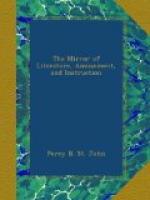[1] See mirror, vol xiii. p. 114.
About the middle of the eighteenth century, this estate passed to a private gentleman, who built a handsome mansion here. But the chief attractions are the natural beauties of the grounds—as the rock, on which the house and chapel are built. Here is shown a cave, devoutly believed by neighbouring peasants to be that which Guy “hewed with his own hands,” and in which he lived
Like a Palmer poore.
The chapel founded by Richard Beauchamp was a plain, substantial edifice. The founder caused to be carved from the solid rock on which this chapel abuts, a rude statue of the famous Earl Guy, about eight feet in height. It would appear, from a print in Dugdale’s Warwickshire, that this figure was well preserved in the seventeenth century.
* * * * *
ANCIENT CROSSES IN ENGLAND.
(For the Mirror.)
“She
doth stray about
By holy crosses, where she kneels
and prays
For happy wedlock hours.”
SHAKSPEARE.
In former times, an idea of peculiar sanctity was annexed to crosses. They not only marked civil and ecclesiastical limits, but probably served for stations, when the bounds were visited in processions. It was a common practice for mendicants to place themselves near some of these crosses, and ask alms; whence the ancient proverb, “He begs like a cripple at a cross.” Cornwall abounds with stone crosses. In churchyards, by the side of roads, and on the open downs, they remain solitary and neglected. In almost every town that had an abbey, or any other religious foundation, there was one of these structures. The monks frequently harangued the populace from these crosses. Many of them still remain, exhibiting beautiful specimens of architecture and sculpture. The most memorable and interesting objects of this kind were those which King Edward I. erected at the different stages where the corpse of Queen Eleanor rested, in its progress from Nottinghamshire to London. Mr. Gough tells us, that there were originally fifteen of these elegant structures; but only three are now remaining, which, by their peculiar beauty, as specimens of architecture and productions of art, serve to excite regret at the destruction of the others. The first of the three above-mentioned, is the cross at Geddington, about three miles from Kettering, in Northamptonshire. The second is the Queen’s Cross, near Northampton. The third is the cross at Waltham, in Hertfordshire. For a further account of these crosses, see Mr. Britton’s “Architectural Antiquities of Great Britain.”
P.T.W.
* * * * *
TO R.H., ON HER DEPARTURE FOR LONDON.
(For the Mirror.)
“Alas for me! false hearts I’ve
found, where I had deem’d them true,
And stricken hopes lie all around where’er
I turn my view;
Yet it may be, when far remov’d,
the voice of memory
May yet remind thee how we lov’d,
with its reproving sigh.”




